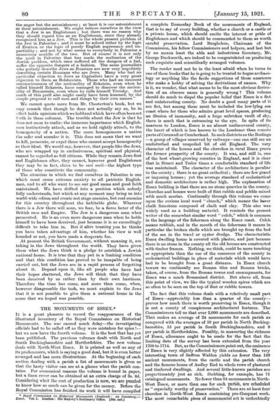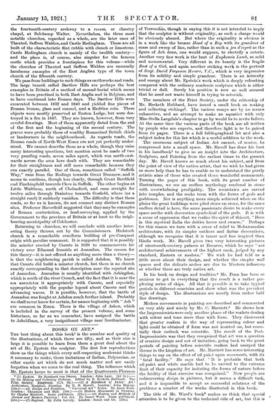THE MONUMENTS OF ESSEX.*
IT is a great pleasure to record the reappearance of the illustrated inventory of the Royal Commission on Historical Monuments. The war caused much delay—the investigating officials had to be called off as they were mistaken for spies !- but we now have the fourth volume. It is the best that has yet been published. The previous volumes dealt with North and South Buckinghamshire and Hertfordshire. The new volume deals with North-West Essex. It is printed as well as any of its predecessors, which is saying a good deal, but it is even better arranged and has more illustrations. At the beginning of each section dealing with a parish a list of monuments is given so that the hasty visitor can see at a glance what the parish con- tains. For economical reasons the volume is bound in paper, but a linen cover can be obtained at an extra charge of 3s. 6d. Considering what the cost of production is now, we are puzzled to know how so much can be given for the money. Before the Royal Commission has finished its work it will have compiled • Royal Commission on Historical Monuments (England) : an Inventory.— Esser. Vol. 1. London : His Majesty's Stationery Office. [80s. net.]
a complete Domesday Book of the monuments of England, that is to say of every building, whether a church or a castle or a private house, which should excite the interest or pride of Englishmen and which should be commended to them as worth careful preservation. Lord Burghclere, Chairman of the Commission, his fellow Commissioners and helpers, and last but by no means least the able and industrious Secretary, Mr. George Duckworth, are indeed to be congratulated on producing such exquisite and scientifically arranged volumes.
The reader need not be in the least afraid when he turns to one of these books that he is going to be treated to bogus archaeo- logy or anything like the facile suggestions of those amateurs who make a hobby of solving the derivations of names. Why is it, we wonder, that what seems to be the most obvious deriva- tion of an obscure name is generally wrong ? This volume should do much to dispel the popular belief that Essex is a flat and uninteresting county. No doubt a good many parts of it are flat, but among these must be included the low-lying sea coast where for those who admire great level spaces, producing an illusion of immensity, and a huge unbroken vault of sky, there is much that is entrancing to the eye. In spite of its nearness to London, Essex is an almost undiscovered county, the heart of which is less known to the Londoner than remote parts of Cornwall or Cumberland. In such districts as the Rodings —a group of villages unserved by railways—one can still see an undisturbed and unspoiled bit of old England. The very character of the houses and the churches in rural Essex prove the former prosperity of the county. It was, and still is, one of the best wheat-growing counties in England, and it is clear that in Stuart and Tudor times a comfortable standard of life was maintained. The character of the architecture is peculiar to the county ; there is no great cathedral ; there are few grand or imposing houses ; yet the average standard of ecclesiastical and domestic architecture is rather high. The explanation of Essex building is that there are no stone quarries in the county. Churches and houses were built of flint rubble and pebble mixed with much mortar. Continually through this volume we come upon the curious local word " °lunch," which means the leaver chalk limestone composed of chalk and clay. This also was widely used as a building material. It reminds the present writer of the somewhat similar word " ankh," which is common in the language of the fishermen along the Essex coast. Culch means rubbish, and in the mouth of the fisherman it means in particular the broken shells which are brought up from the bed of the sea in the trawl or oyster dredge. The characteristic Essex dwelling house is covered with plaster, and just because there is no stone in the county all the old houses are constructed with timber frames. Nothing, we think, could be more touching or appropriate than the use of the resources of the county in ecclesiastical buildings in place of materials which would have had to be brought from a great distance. In Essex church towers we continually see Roman tiles and Roman bricks, taken, of course, from the Roman towns and encampments, for Essex was a much Romanised district. But above all, from this point of view, we like the typical wooden spires which are so often to be seen on the top of flint or rubble towers.
The fact that this volume deals with a relatively small part of Essex—appreciably less than a quarter of the county— proves how much there is worth preserving in Essex, though it is not a county of conspicuous architectural features. The Commissioners tell us that over 2,000 monuments are described. That makes an average of 24 monuments for each parish as compared with the averages of 10 per parish in North Bucking- hamshire, 15 per parish in South Buckinghamshire, and 8 per parish in Hertfordshire. Possibly, in measuring the richness of Essex, allowance ought to be made for the fact that the limiting date of the survey has been extended from the year 1700 to 1714. But, as the Commissioners point out, the eminence of Essex is very slightly affected by this extension. The very interesting town of Saffron Walden yields no fewer than 159 ancient monuments, from the castle and the parish church and the famous house of Audley End to whole rows of plastered and timbered dwellings. And several little-known parishes are proportionately just as rich. Stebbing, for example, has 71 catalogued monuments. No fewer than 84 monuments in North- West Essex, or more than one for each parish, are scheduled as " especially worthy of preservation." There are at least four churches in North-West Essex containing pre-Conquest work. The most remarkable piece of monumental art is undoubtedly
the fourteenth-century archway to a recess, or chantry chapel, at Belohamp Walter. Nevertheless, the three most notable churches, regarded as a whole, are the later ones of Thaxted, Saffron Walden, and Castle Hedingham. These are all built of the characteristic flint rubble with clunch or limestone. Castle Hedingham church is mainly of the twelfth century— and the place is, of course, also singular for the famous castle which provides a frontispiece for this volume—while the churches of Thaxted and Saffron Walden are unusually handsome examples of the East Anglian type of the town church of the fifteenth century.
We pass from buildings to such things as earthworks and roads. The large tumuli called Bartlow Hills are perhaps the best examples in Britain of a method of mound-burial which seems to have been practised in both East Anglia and in Belgium, and to have continued into Roman days. The Bartlow Hills were excavated between 1832 and 1840 and yielded fine pieces of Roman bronze, glass and enamel, and a Hadrian coin. These objects were mostly preserved at Easton Lodge, but were des- troyed in a fire in 1847. They are known, however, from very careful drawings. Most of them apparently dated from the end of the first and the beginning of the second century. The graven were probably those of wealthy Romanised British chiefs or landowners in the neighbourhood. As regards roads, the Roman roads of North-West Essex are not yet perfectly under- stood. We cannot describe them as a whole, though they raise many interesting questions, but mention must be made of two very puzzling roads, seven miles apart, which run north-east- wards across the area here dealt with. They are remarkable for their straightness and still more remarkable because they run exactly parallel. One of them, sometimes called " Suffolk Way," runs from the Rodings towards Great Dunmow, and it seems to continue, though less clearly, through Great Bardfield and Finchingfield towards Clare in Suffolk. The other begins at Little Waltham, north of Chelmsford, and runs straight for twelve miles through Braintree towards Gosfield, where (as a straight road) it suddenly vanishes. The difficulty is that these roads, so far as is known, do not connect any distinct Roman sites. Professor Haverfield suggested that they may be examples of Roman centuriation, or land-surveying, applied by the Government to the province of Britain or at least to the neigh- bouring municipality of Colchester.
Returning to churches, we will conclude with another inter- esting theory thrown out by the Commissioners. Hadstock church is a remarkable cruciform building of pre-Conquest origin with peculiar ornament. It is suggested that it is possibly the minster erected by Canute in 1020 to commemorate his victory over Edmund Ironside at Assandun. The reason for this theory—it is not offered as anything more than a theory— is that the neighbouring parish is called Ashdon. We know that Canute did build a minster church, but there is no church exactly corresponding to that description near the reputed site of Assandun. Assandun is usually identified with Ashingdon, which is south of the river Crouch, and the fact that it is near the sea associates it appropriately with Canute, and especially appropriately with the popular legend about Canute and the advancing waves. It is possible, however, that the battle of Assandun was fought at Ashdon much further inland. Probably we shall never know for certain, for names beginning with " Ash " are common in Essex. There is the village of Ashen, which is included in the survey of the present volume, and some historians, so far as we remember, have assigned the battle to Asheldham, a very insignificant village near Southminster.































 Previous page
Previous page